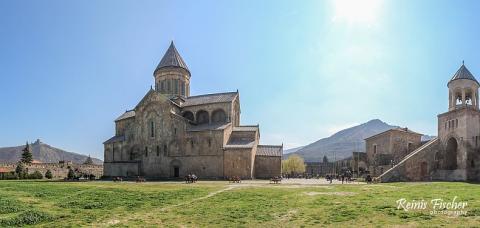Svetitskhoveli Cathedral is an another must have tourist attraction site not to miss when traveling to Georgia. Located in historical and picturesque town of Mtskheta some 20 km from nation's capital Tbilisi.
It is the second largest church building in the country, after the Holy Trinity Cathedral of Tbilisi (Sameba), and is listed as an UNESCO World Heritage Site along with other historical monuments of Mtskheta.
Rumor has it - Jesus robe (mantle) is buried exactly here - well, there are at least three official church versions of Jesus robe destiny, and among them Svetitskhoveli stands out as well:
According to the tradition of the Georgian Orthodox Church, the chiton was acquired by a Jewish Rabbi from Georgia named Elioz (Elias), who was present in Jerusalem at the time of the crucifixion and bought the robe from a soldier. He brought it with him when he returned to his native town of Mtskheta, Georgia, where it is preserved to this day beneath a crypt in the Patriarchal Svetitskhoveli Cathedral.
There is even an official holiday dedicated to this event, and is named Mtskhetoba (Svetitskovloba), which happens on October 14.

Svetitskhoveli cathedral in Mtskheta
Together with Jvari monastery Svetitskoveli cathedral are one of the main sights in Mtksheta.
Cathedral has been built in the 4th century, but has been damaged several times during history, notably by the invasions of Arabs, Persians, and Timur and latterly during Russian subjugation and the Soviet period. The building has also been damaged by earthquakes. In the 11th century, the present Svetitskhoveli Cathedral was rebuilt (from 1010 to 1029) in the Cross-Dome style.
The cathedral is surrounded by a defensive wall, built of stone and brick during the reign of King Erekle II (Heraclius) in 1787.

Svetitskhoveli Cathedral
The interior walls are painted with frescoes, most of which have not survived in their original state. In the 1830s, when Czar Nicholas I was scheduled to visit Mskheta, the frescoes were all whitewashed, although in the end the Czar never came. Today, after much careful restoration, some few remnants survive including fragments of a 13th-century Beast of the Apocalypse and figures of the Zodiac.
The walls are decorated with many Christian Orthodox icons, most of which are not original (the originals being in the national museums of Georgia). The decoration of the church stonework also features carved grapes (as in many churches of Georgia), reflecting the country's ancient wine-making traditions. The large figure of Jesus at the altar was painted by Russian artist in the 19th century. The majority of the icons here date to the 20th century. Some are copies of older icons and frescoes from other churches throughout Georgia.

Panorama of Svetitskhoveli Cathedral
Tips for getting here - if you don't have your own vehicle and you are not traveling with a tour guide - you should take a taxi from Tbilisi (I recommend using Taxify app, so it will be cheaper, faster and safier) and the price should be around 15-20 GEL. For me getting here I took a marshurtka to Tbilisi Mall at first and then from there I negotiated a taxi for 7 GEL to Mtksheta. For getting back to Tbilisi - again - taxi's or local marshrutkas (there are some going to Didube station, and the price is just one lari (as of 2016)





